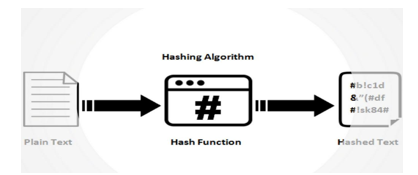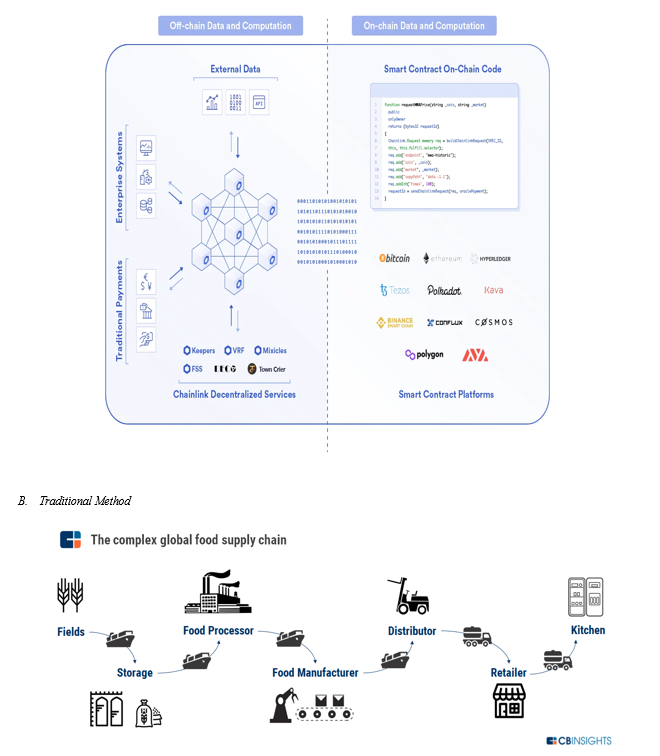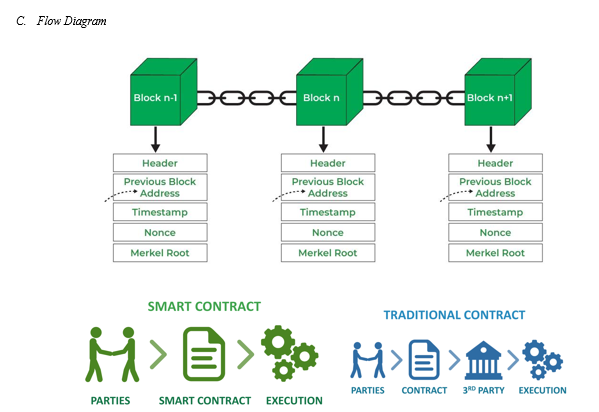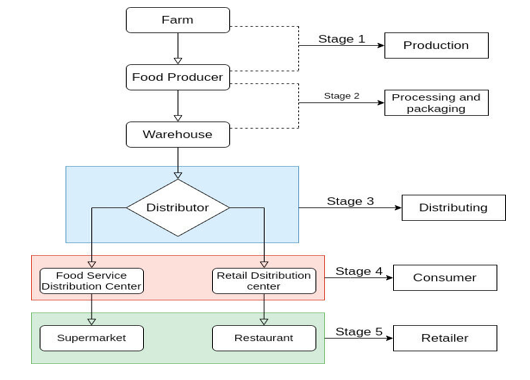Ijraset Journal For Research in Applied Science and Engineering Technology
- Home / Ijraset
- On This Page
- Abstract
- Introduction
- Conclusion
- References
- Copyright
Development Secured Blockchain Based on Agricultural Food Supply Chain in Management System
Authors: M. Monika, A. Gowsika, Miss. B. Vasanthi
DOI Link: https://doi.org/10.22214/ijraset.2024.61537
Certificate: View Certificate
Abstract
Blockchain, smart contracts, and the Internet of Things (IoT) are essential technologies for the business process re-engineering of supply chains in the era of Industry 4.0. The agricultural food supply chain is one of the research areas where these disruptive technologies can play a crucial role in automating business processes, providing real-time goods monitoring, and securing transactions. With the help of blockchain, smart contracts, and the IoT, a product’s health and environment can be monitored throughout the supply chain. In this study, we have critically examined the relevance of these technologies through various activities of the agriculture supply chain using the approach of Business Process Modeling (BPM). Agriculture is a big part of the economy of any country because it helps feed the entire population. It connects and communicates with all of the related industries. If the agriculture base is strong, it is generally regarded as a socially and politically stable society. Many modern farms make use of cutting-edge technology and sciatic and technological ideas. The maximization of the profits relies on some farmers’ vegetables and fruits with chemicals. Chemical fertilizers, insecticides, and other compounds are used in several plants and fruits. As a result, pesticide residues in vegetables and fruits become excessive. It is a significant health risk. Food gets contaminated with heavy metals. irrigation water source of crops is polluted by the excessive intrusion of heavy metal elements such as lead, tin, mercury and zinc, which are dangerous to human health. Food additives are used excessively in food processing. Some nefarious enterprises use excessive food additives, antibiotics, hormones and harmful substances.
Introduction
I. INTRODUCTION
Supply chain management (SCM) despite its maturity is continually being rebuilt by disruptive technologies like the Internet of Things (IoT), blockchain and smart contracts. Globalizregulated intricate regulatory policies have made supply chains complex. Information management systems for supply chains are generally centralized, requiring entities to trust one broker with sensitive data and information.
Centralized information systems have the disadvantage of a single point of failure and are more susceptible to hacking and other attacks.
Customers always demand better quality products delivered on time and at the right price, which is a big challenge in supply chain management. Consumers also demand visibility and traceability to keep track of their orders.
Traceability or tracking a product through all supply chain stages,is more of a demand than a request, as almost every customer wants to know the product’s origin and ingredients. Maintaining supply chain visibility and tracking shipments become tough when multiple carriers, third-party logistics providers and modes of transportation are used. Lack of traceability can create blind spots in the supply chain and weaken the customer’s trust, which can eventually cause lower sales and lead to less profit. Transportation delays and poor storage practices in warehouses are common causes that can affect the safety and quality of products.
Lack of communication also has a significant impact on the supply chain because there are several parties involved that have little or no knowledge of other entities’ actions. Poor communication among parties may cause inefficiency, leading to trust issues among suppliers and customers. If the supply chain operates globally, trust issues get much worse. Blockchain is the solution to the majority of supply chain problems, such as information sharing between parties, data tampering and lack of transparency.
Major Areas where blockchain can be most helpful are in Food Supply Chain and even in Information and Communication Technology, such as remotely monitoring farm conditions and enhancing irrigation systems using those conditions
Blockchain is a distributed database that stores information electronically in digital format. Blockchain guarantees the fidelity and security of the record of data. It generates trust without the need for a trusted third party which can be very helpful for the food supply chain. The Major purpose or the need for blockchain in agriculture is to bring out transparency and immutability in data. Data from monitoring systems or from the food supply chain is needed to be secured from various entities participating .
in the food supply chain such as farmers, consumers, etc.
Blockchain is based on Computation power, Internet Speed, and Data; the competitiveness and cost-effectiveness.It contains details of the components, origin, processing, transportation and storage conditions of the food. In a nutshell, we can say that it includes the entire process of how food grown on a farm makes its way to the dinner table. It includes production, processing, transporting, retailing, and consumption.
Throughout this, food is moved from a farmer producing the crop to the consumer buying it from stores. Every step requires raw materials and labor to take it to the next step. There is a list of steps.
II. RELATED WORK
Blockchain technologies can track all types of information about plants, such as seed quality, and crop growth, and even generate a record of the journey of the plant after it leaves the farm. This data can improve supply chain transparency and eliminate concerns associated with illegal and unethical operations. In the case of a recall, they can also make it easier to track any contamination or other issues back to their source. The primary goals of these technologies are sustainability and food security. When consumers have this amount of transparency, they can make informed purchasing decisions. They frequently utilize this information to reward farmers and producers that implement good farming methods. Initially, when a user creates a transaction over a Blockchain network, a block will be created, representing that transaction is created. Once a block is created, the requested transaction is broadcasted over the peer-to-peer network, consisting of computers, known as nodes, which then validate the transaction.
A verified transaction can involve cryptocurrency, contracts, records, or any other valuable information. Once a transaction is verified, it is combined with other blocks to create a new block of data for the ledger.Here it is important to note that with each new transaction, a secured block is created, which is secured and bound to each other using cryptographic principles. Whenever a new block is created, it is added to the existing Blockchain network confirming that it is secured and immutable.
- A transaction is initiated. This can be a transfer of funds, a contract agreement, or any other type of data exchange.
- The transaction is broadcasted to the Blockchain network.
- The transaction is verified by the network nodes. This process is known as mining. If you want to know more about mining you can check out our article on how Bitcoin is mined.
- Once the transaction is verified, it is added to a block. Each block contains a group of verified transactions. It also includes a hash of the previous block. This creates a chain of blocks. That is how Blockchain technology gets its name.
- The new block is added to the Blockchain network.
III. WHAT IS BLOCKCHAIN TECHNOLOGY?
databases are currently using ict (information and communication technology) to track data and manage information flow. the use of blockchain technology to power these databases is a novel concept. they distribute privileges to all network members rather than having a single server and administrator. multiple parties can then access and validate new database additions, increasing security and lowering the risk of corruption.
IV. HOW BLOCKCHAIN TECHNOLOGY CAN REVOLUTIONIZE AGRICULTURE SECTOR?
blockchain is a technology that can bring breakthroughs in the agri sector with its potential. by allowing information to be traced across the agricultural supply chain, blockchain agriculture enhances food safety. the ability of blockchain to store and manage data allows for traceability, which is used to aid in the development and implementation of intelligent farming and index-based crop insurance systems.
V. BARRIERS TO USING BLOCKCHAIN TECHNOLOGIES
concerns have been raised that blockchain technology could be misapplied or misused, putting food security at risk. for example, privately held blockchains are easier to hack and less secure. because these blockchains are based on private organisation norms, it's easy to see how the wrong people could take advantage of them. small-scale farmers, on the other hand, who lack the necessary size, technological know-how, and scalability to take advantage of blockchain technology, may be left behind.
many issues must be resolved before blockchain technology can be completely incorporated into agriculture.first, blockchain implementation must be decentralized to accommodate small farmers and rural dwellers. otherwise, food security will remain a problem. implementation must enable sustainable and equitable food systems, allowing consumers to make a better decisions.
those who lack the digital literacy required to engage in blockchain technology must be educated. this is part of the system's decentralisation process. because of aged infrastructure and a lack of digital literacy, the world's poor may be unable to participate.
VI. WHY BLOCKCHAIN TECHNOLOGY CAN BE THE GAME-CHANGER FOR BOOSTERING FARMING IN INDIA?
- While the food goes through many different players on its journey from the farm to the food plate, there is a strong urge by consumers today to know what are they eating. also, as supply chains have become longer, any user becomes more concerned about the origin and journey of the produce.
- Blockchain is the only way that traceability can be brought reliably to farm produce with the distributed market architecture.
- Iot devices and sensors are being introduced by agritech companies, and blockchain technology can be used to consolidate data on a variety of topics, including seed quality, crop tracking, and the path of crops from the farm to the market.
- Apart from increasing transparency in the food supply chain, blockchain technology can also improve security by prohibiting unethical crop production and distribution, which endangers farmers' livelihoods.
- Consumers will be able to make more educated decisions thanks to blockchain's data collection, and they may even be able to help small-scale farmers who are often in need of food and financial security.
- Before the data can be preserved, it must first be formatted and made comprehensible. blockchain technology makes it easier to add meta information to data and structure. it can be saved after that, making compliance enforcement easier. data compliance ensures that the information gathered is kept secure and secured.
VII. METHODOLOGY
- Symmetric Encryption: This can be called the oldest and simplest form of digital secret-keeping. It uses a single secret key to both lock and unlock data. While it’s fast and easy, there’s a catch: Anyone with the key can access the data.
- Asymmetric Encryption: Next is the asymmetric encryption. This is more secure than symmetric encryption. It employs two keys. A public key for locking data and a private key for unlocking it. Only the holder of the private key can access the data. It’s slower but way more secure.
- Hash Functions: Hash functions are like digital fingerprints. They create a unique identifier for data just like our fingerprints. This data can be used to verify the integrity of the hash or check for tampering. Hash functions often work alongside other cryptographic methods.
VIII. USING HASH FUNCTION PRINCIPAL OF BUSINESS PROCESS MODEL OF AFRICULTURE FOOD SUPPLY CHAIN
A. Hashing Algorithm
- Hashing is one of the important techniques under modern cryptography.
- Hashing is the process of converting data into a message called hash code using mathematical function referred as Hash function.

Hashing is based on one way encryption and hence is irreversible that means one can't retrieve data from hash code.
The ideal cryptographic hash function has the following main properties:
a. Deterministic: A message will always result in the same hash code.
b. Quick: Hash function is fast to compute the hash value.
c. Irreversible: It is not possible to generate a message from hash code.
d. No Collision: It ensures that two different messages should not have the same hash value.
e. Unique: It ensures that a small change to a message extensively changes the hash value.
Since the introduction of modern cryptography there has been continuous development and improvement in hashing algorithms to ensure security and protection from attacks on hashed data.
Comparison of various hashing mechanisms is shown in Table and SHA256 has been a popular hashing algorithm widely used for Digital certificates under HTTPs for web applications.
|
Algorithm |
Hash Size |
Message size |
Block size |
Word size |
No. of steps |
|
MD5 |
128 |
<264 |
512 |
32 |
64 |
|
SHA-1 |
160 |
<264 |
512 |
32 |
80 |
|
SHA-256 |
256 |
<264 |
512 |
32 |
64 |
|
SHA-384 |
384 |
<2128 |
1024 |
64 |
80 |
|
SHA-512 |
512 |
<2128 |
1024 |
64 |
80 |
Table Comparison of various hashing mechanism
IX. USING HYBRID SMART CONTRACT PRINCIPAL OF BUSINESS PROCESS MODEL OF AFRICULTURE FOOD SUPPLY CHAIN
A. Hybrid Smart Contracts
Hybrid smart contracts combine code running on the blockchain (on-chain) with data and computation from outside the blockchain (off-chain) provided by decentralized oracle networks.
A hybrid smart contract combines on-chain infrastructure with off-chain data and computation provided by decentralized oracle networks to create a feature-rich decentralized application. By being able to seamlessly combine on-chain and off-chain components, hybrid smart contracts can unlock smart contract use cases and functionality that wouldn’t be possible by using just one of the components.
- On-Chain: Blockchain
- Maintain a persistent ledger that provides authoritative custody of users’ assets and interacts with private keys
- Execute final settlement by processing irreversible transactions that transfer value between users
- Provide dispute resolution and guardrails to secure the proper functioning of the off-chain services performed by a DON
2. Off-Chain: Decentralized Oracle Network
- Fetch, validate, secure, and deliver data from external APIs to smart contracts running on blockchains and layer-2 solutions
- Perform various types of computations for smart contracts running on blockchains and layer-2 solutions
- Relay outputs of smart contract code to other blockchains or external systems.
- Hybrid smart contracts combine on-chain code with off-chain decentralized oracle networks to enable more advanced blockchain-based applications.


- Decentralization: In standard centralized group action systems, every group action must be valid through the central trustworthy agency (e.g., the central bank), inevitably ensuing to the value and therefore the performance bottlenecks at the central servers. Distinction to the centralized mode, third party is not any longer required in blockchain. Accord algorithms in blockchain are accustomed maintain information consistency in distributed network
- Persistency: Transactions are often valid quickly and invalid transactions wouldn't be admitted by honest miners. It’s nearly not possible to delete or rollback transactions once they're enclosed within the blockchain. Blocks that contain invalid transactions may well be discovered directly.
- Anonymity: Every user will act with the blockchain with a generated address, that doesn't reveal the $64000 identity of the user. Note that blockchain cannot guarantee the proper privacy preservation thanks to the intrinsic constraint .
- Auditability: Bitcoin blockchain stores knowledge regarding user balances supported the unexpended dealings Output (UTXO) model: Any dealings must ask some previous unexpended transactions. Once this dealing is recorded into the blockchain, the state of these referred unexpended transactions switch from unexpended to spent. Therefore, transactions may well be simply verified and tracked.
D. Post References Model
- Traditional supply chain management is a rigid system focused on product production. Your team sources materials, provides them to a manufacturer to make the product, then sends them to a retailer or other sales channel to be delivered to the customer. Any issues along the way are manually dealt with, which can be hard to manage especially as large volumes of products are being produced.
- With the life-cycle of products being much shorter, and consumers expecting to have an abundance of choices, this model is no longer cost-effective when trying to source items that are in line with customer demands. Instead, modern supply chain management leverages automation and technology insights to better accommodate the needs of your customer.

Conclusion
Blockchain technology possessing such a large appeal, we are already seeing widespread adoption. As nearly every industry utilizes some sort of agile, record keeping practices, it is not unreasonable to expect to see this technology applied to a wide range of applications some of which are hinted at in our previous sections such as the potential for a smart city, while others are either still in development or have yet to be discovered. Furthermore, due to the peer-to-peer nature of the technology this technology and every stakeholder having access to their block of the ledger, cooking the books or falsifying data has never been harder. This alone has the potential to increase consumer confidence in these new technological disruptions. As with any new technology, the underpinnings are not well understood and for that reason it is difficult to say how widely adopted the technology will be. Future research should delve into these topics and new applied applications, as well as study adoption rates of the technology. For those who do adapt blockchain, further study would grant us insights as to what increases (if any) in productivity have been recorded. Studies may also focus on roadblocks as to why this technology has not been adopted as well as investigate trends in consumer confidence. Additionally, as technology increases, future studies may help shed light on any security issues not initially discovered. With what started as some posted code by an anonymous programmer with a goal of creating a new currency platform, blockchain has skyrocketed in popularity, with nearly every industry from finance and healthcare, all the way to education and city planning. In conclusion, blockchain technology appears to not only improve tasks in current industries, but also hold the potential to revolutionize systems that keep track of the history of artifacts through a vastly improved, transparent ledger system.
References
[1] Agri-4-All: A Framework for Blockchain Based Agricultural Food Supply Chains in the Era of Fourth Industrial Revolution ZEESHAN RAZA 1 , IRFAN UL HAQ 1 , AND MUHAMMAD MUNEEB 2 Received 3 January 2023, accepted 22 February 2023, date of publication 21 March 2023, date of current version 29 March 2023. Digital Object Identifier 10.1109/ACCESS.2023.3259962. [2] Bitcoin equilibrium dynamics: a long term approach Jack, R. Rogers on sep 2023. [3] Shaping the future of Ethereum: exploring energy consumption in Proof-of-Work and Proof-of-Stake consensus,Rameez Asif,Syed Raheel Hassan on Aug 2023. [4] Decentralized justice: state of the art, recurring criticisms and next-generation research topics Federico Ast,William George,Jamilya Kamalova,Abeer Sharma and Yann Aouidef on oct 2023. [5] Z. Raza, I. U. Haq, M. Muneeb, and O. Shafiq, ‘‘Energy efficient multiprocessing solo mining algorithms for public blockchain systems,’’ Sci. Program., vol. 2021, pp. 1–13, Oct. 2021. [6] A.C. Tagarakis, L. Benos, D. Kateris, N. Tsotsolas, and D. Bochtis, ‘‘Bridging the gaps in traceability systems for fresh produce supply chains: Overview and development of an integrated IoT-based system,’’ Appl. Sci., vol. 11, no. 16, p. 7596, Aug. 2021. [7] F. Casino, V. Kanakaris, T. K. Dasaklis, S. Moschuris, S. Stachtiaris, M. Pagoni, and N. P. Rachaniotis, ‘‘Blockchain-based food supply chain traceability: A case study in the dairy sector,’’ Int. J. Prod. Res., vol. 59, no. 19, pp. 5758–5770, Oct. 2021 [8] S. Hu, S. Huang, J. Huang, and J. Su, ‘‘Blockchain and edge computing technology enabling organic agricultural supply chain: A framework solution to trust crisis,’’ Comput. Ind. Eng., vol. 153, Mar. 2021, Art. no. 107079. [9] Y. Bai, K. Fan, K. Zhang, X. Cheng, H. Li, and Y. Yang, ‘‘Blockchainbased trust management for agricultural green supply: A game theoretic approach,’’ J. Cleaner Prod., vol. 310, Aug. 2021, Art. no. 127407. [10] S. Awan, S. Ahmed, F. Ullah, A. Nawaz, A. Khan, M. I. Uddin, A. Alharbi, W. Alosaimi, and H. Alyami, ‘‘IoT with BlockChain: A futuristic approach in agriculture and food supply chain,’’ Wireless Commun. Mobile Comput., vol. 2021, pp. 1–14, Jun. 2021. [11] R. Guido, G. Mirabelli, E. Palermo, and V. Solina, ‘‘A framework for food traceability: Case study–Italian extra-virgin olive oil supply chain,’’ Int. J. Ind. Eng. Manage., vol. 11, no. 1, pp. 50–60, Mar. 2020. [12] R. Iqbal and T. A. Butt, ‘‘Safe farming as a service of blockchain-based supply chain management for improved transparency,’’ Cluster Comput., vol. 23, no. 3, pp. 2139–2150, Sep. 2020. [13] Blockchain has the Potential to Revolutionize the Supply Chain | TechCrunch. Accessed: Mar. 22, 2023. [Online]. Available: https://techcrunch.com/2016/11/24/blockchain-has-the-potential-torevolutionize-the-supply-chain/ [14] M. Muneeb, Z. Raza, I. U. Haq, and O. Shafiq, ‘‘SmartCon: A blockchainbased framework for smart contracts and transaction management,’’ IEEE Access, vol. 10, pp. 23687–23699, 2022. [15] M. Muneeb and Z. Raza, ‘‘Tree-based blockchain architecture for supply chain,’’ Int. J. Blockchains Cryptocurrencies, vol. 2, no. 2, p. 143, 2021, doi: 10.1504/ijbc.2021.118113. [16] Z. Wang, T. Wang, H. Hu, J. Gong, X. Ren, and Q. Xiao, ‘‘Blockchainbased framework for improving supply chain traceability and information sharing in precast construction,’’ Autom. Construct., vol. 111, Mar. 2020, Art. no. 103063 [17] P. K. Wan, L. Huang, and H. Holtskog, ‘‘Blockchain-enabled information sharing within a supply chain: A systematic literature review,’’ IEEE Access, vol. 8, pp. 49645–49656, 2020. [18] XAG and Huawei Cooperate on 5G-Powered Smart Agriculture. Accessed: May 9, 2022. [Online]. Available: https://www.prnewswire.com/newsreleases/xag-and-huawei-cooperate-on-5g-powered-smart-agriculture300909034.html [19] C. Esposito, M. Ficco, and B. B. Gupta, ‘‘Blockchain-based authentication and authorization for smart city applications,’’ Inf. Process. Manage., vol. 58, no. 2, Mar. 2021, Art. no. 102468 [20] What’s the Ideal Moisture Level for Soil to Grow Crops? Accessed: Sep. 17, 2022. [Online]. Available: https://www.delmhorst.com/blog/whats-the-ideal-moisture-level-forsoil-to-grow-crops [21] Chapter 3: Determination of the Irrigation Schedule for Crops Other Than Rice. Accessed: Sep. 20, 2022. [Online]. Available: https://www.fao. org/3/t7202e/t7202e06.htm [22] Tomato Fertilizing Guide—From Seedling to the End of the Season. Accessed: Sep. 21, 2022. [Online]. Available: https://www.ruralsprout. com/tomato-fertilizer-guide/#:~:text=Tomatoes%20grown%20in%20the %20ground,fertilizing%20more%20frequently%20than%20weekly [23] How to Manage Tomato Leaf Spot Diseases. Accessed: Sep. 20, 2022. [Online]. Available: https://www.lsuagcenter.com/ profiles/mhferguson/articles/page1590779196725 [24] Growing Healthy Tomatoes | Kings Plant Doctor. Accessed: Sep. 20, 2022. [Online]. Available: https://plantdoctor.co.nz/garden-advice/growinghealthy-tomatoes/ [25] Herbicide Treatment Table/Tomato/Agriculture: Pest Management Guidelines/UC Statewide IPM Program (UC IPM). Accessed: Sep. 20, 2022. [Online]. Available: https://www2.ipm.ucanr.edu/ agriculture/tomato/Herbicide-Treatment-Table/
Copyright
Copyright © 2024 M. Monika, A. Gowsika, Miss. B. Vasanthi . This is an open access article distributed under the Creative Commons Attribution License, which permits unrestricted use, distribution, and reproduction in any medium, provided the original work is properly cited.

Download Paper
Paper Id : IJRASET61537
Publish Date : 2024-05-03
ISSN : 2321-9653
Publisher Name : IJRASET
DOI Link : Click Here
 Submit Paper Online
Submit Paper Online

